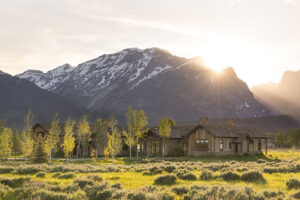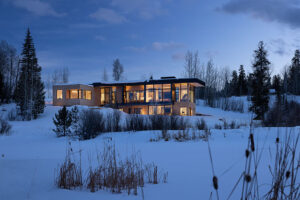Building Considerations in JH
+ Story by David Porter
+ Photography by Latham Jenkins
Jackson enjoys a wealth of design, engineering and contracting experts who can help you build the perfect home, one that analyzes a number of elements that you may not have taken into consideration. Working in concert with an architect, an engineer, a contractor and a land management specialist, you can make your dream come true while building a structure that should last for the next century or longer. There is a lot to think about, from the soil your home sits on to earthquakes, floods, wildlife and fire.

Architect and contractor discuss plans and strategies for construction of this home, working together from the beginning of the process to the end.
What can you expect from your architect? Arne Jorgensen, co-principal of Hawtin Jorgensen Architects, says he relies on close communication with Jackson’s many construction experts to ensure that any plan is well thought out, creating a home that is aesthetic yet strong. Jorgensen says that any architect should be with you throughout the planning and construction process. He says an architect “is not unlike a conductor in an orchestra or the editor of a magazine or book,” somebody who holds the vision of the entire project and works with others to deliver the product the homeowner desires.

Engineer Reed Armijo stands on a Snake River levee. Levees are assessed and maintained by the U.S. Bureau of Reclamation; they protect river-bottom homes from high spring runoff.
John Walker of Mill Iron Timberworks has nearly 30 years’ experience building in Jackson. He advises readers to be careful when working with architects, engineers and builders from outside the valley. Walker says, “It’s not that they wouldn’t be qualified and experienced, just not experienced in building here.” There are many technicalities when it comes to building in the valley, and the local experts know the nuances.
When it comes to a structure that’s sound, start with soil composition: A home’s foundation should be rock-solid. “Settling isn’t a problem in Jackson Hole if the foundation is properly engineered,” says Reed Armijo, principal of Jorgensen Associates, PC. “Our valley floor is river bottom and is therefore full of rock, a foundation setting that is ideal.” Armijo says, however, that hillside construction presents less-stable soil, called loess, a silt-and-clay substance prevalent around Jackson. “If the moisture content of loess is not ideal, there will be shifts in the soil,” Armijo says, “but we can mitigate that.” Sinking helical piers deep into the soil to reach stable layers for footings and foundations provides that all-important stable base in loess. Kurt Wimberg of Kurt Wimberg Construction has used helical piers on a number of homes he’s built: “The cost of engineering and construction is increased when such mitigations are needed, but they result in a sound home,” one Wimberg says should be around for 100 years or more.

This home designed by architect Stephen Dynia includes large windows that face south to allow passive solar gain, a simple energy conservation technique that also makes for inviting, bright indoor living spaces.
Earthquakes and jolts can do great damage, especially to older structures. Jorgensen, Armijo and Wimberg all agree that a well-built home might shake in a large quake, but that it should withstand the tremors. A firm foundation is a great start, yet more stabilization must be included above-ground. First, Teton County builders follow codes adopted from California and the International Building Code. The codes set our area in Earthquake Zone 4, the same zone as California. Wimberg, who attends building science courses, says he uses “more steel than in the past and plenty of Simpson brackets, tie-downs and plates.” There are also plywood-sheering and nail-pattern codes to follow to ensure that the structure is sound. Armijo says that engineers worldwide have studied structures that withstand major quakes to learn “what parts of buildings to make more rigid and what parts to make looser.”
And, it snows in Jackson Hole. A lot! Snow load, the amount of snow the roof must carry, can vary depending on where homes are located in the valley. Wimberg, using county maps, finds “loads vary from 60-120 pounds per square foot.” Along with the installation of burly roof trusses, earthquake mitigation strategies also handle heavy snow; so two considerations can be controlled with the same tactics.
Dynia Architects founder Stephen Dynia stresses the importance of the home’s orientation on the lot when it comes to snow and wind exposure. Dynia states, “An understanding of windward and leeward snow accumulation patterns is essential to properly locating garage and entry doors to minimize constant snow removal.” Although you will be tempted to orient your home to take advantage of views, consider the resources and work involved in moving snow. Dynia and architect Larry Berlin of Berlin Architects also note the importance of ventilation in the attic, called a “cold roof,” to control moisture and ice buildup, or “dams.”

Architect Larry Berlin examines ventilation on the roof crown. Such ventilation creates the “cold roof” that keeps the attic dry and holds snow longer throughout the winter, increasing the roof’s insulation factor.
The cold roof keeps snow on the roof longer, providing natural insulation, and reduces the thaw/freeze cycle because roof temperatures remain more static. Good orientation of the home in respect to snow, wind and where roof valleys lie, coupled with proper ventilation, minimize snow and ice damage and heighten indoor comfort.
When all that snow melts, especially if it melts in a hurry or is accompanied by an extensive rainy period, flooding can occur. Jackson is well protected, though, thanks to a reliable, well-constructed and well-maintained levee system for the Snake River that is regulated by the U.S. Bureau of Reclamation. “The levee system has been tested by heavy spring runoff a number of times and has never failed,” Armijo shared. Although landscape architects don’t always like engineers’ demands for protecting homes from flood, they have to comply with approved plans. Plans show how to divert runoff and floodwaters from homes and can take the form of orienting the home properly on the site, building berms to divert water and creating hollows where water can safely pool.
Another natural element one must contemplate is the land itself. Harry Statter, founder of Firewise and The Landscape Company, brings his knowledge and experience to the homeowner in the form of land management. Statter says, “People want postcard views, yet they must consider the dynamism of nature.” How can you be proactive in managing the land so that it provides a great experience for you and your family and also for the generations to come? When helping owners manage their property, Statter listens to their goals. Let’s say you’d like to increase or extend the periods of wildlife activity on your property. Statter and his staff then inventory patterns of animal use and take steps that might range from mechanical treatment— cutting down trees and shrubs—to prescribed burns, to plantings of native species to attain those goals. These considered actions can also help control wildfire and beetle- killed trees. Statter stresses to property owners, “It is our responsibility as citizens to be stewards of the land,” an environmental ethos strong in Jackson Hole. To live as part of this ethos is why many have settled here.
Within the structure, energy efficiency can be enhanced. Wimberg works with clients to purchase lumber for construction that has been certified by the Forest Sustainable Council. Jorgensen helps clients select windows that allow for thermal gain, trapping heat in winter and repelling heat in the summer months. Armijo, Jorgensen and Wimberg all recommend efficient heat sources. Whether geothermal heat pumps, used with more and more frequency, or in-floor radiant heat controlled by a high-efficiency boiler, or a solar array to heat water or produce electricity, these are solid, forward- thinking choices.

Andy Tyson shows a collective solar array he designed and installed in the south end of the Jackson Hole valley. Even on cloudy days, the system generates clean electricity.
Mistakes with energy efficiency can prove costly, so it pays to do your research. Andy Tyson, owner of Creative Energies, a company that installs renewable energy systems in homes, works with clients to set goals for establishing green systems. Tyson asserts that if efficiency is the goal, keep it in mind from the outset. Tyson says, “It’s kind of like buying a car: If you buy a Hummer and then say, ‘OK, now how can I save gas?’ you’re missing the point of seeking efficiency from the beginning.” Tyson also advises clients to not put a garage on the south side of the home. Homeowners will be tempted to fill the north sides of their homes with windows to face the Teton peaks, but it’s on the south side that the sun will shine through the winter months, where heat can be generated passively simply by letting the sun pass through glass. “It’s also more comfortable to live on the warm, sunny side of the house.” Finally, Tyson encourages his clients to consider a solar/electric system. “People worry they are too expensive to buy and install, but lately, prices have come down considerably. Don’t rule things out until you talk to the experts.”
Jackson Hole is a special place, known the world over for its beauty, wildlife, and more and more for its dynamic community. Because of the unique geology, topography and weather, there is a complexity to building here. Yet with the abundance of expertise in this valley, you’ll find peace of mind in any home-building journey you undertake.







